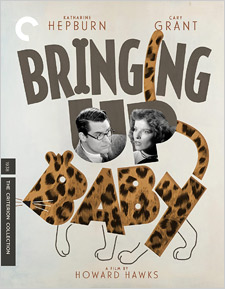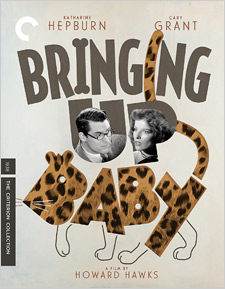Bringing Up Baby (Blu-ray Review)

Director
Howard HawksRelease Date(s)
1938 (July 6, 2021)Studio(s)
RKO Radio Pictures/Warner Bros (Criterion – Spine #1085)- Film/Program Grade: A
- Video Grade: A
- Audio Grade: A-
- Extras Grade: A
Review
Howard Hawks was a director who worked in a variety of genres—Western (Rio Bravo), noir (The Big Sleep), gangster (Scarface), and comedy (His Girl Friday). Despite his impressive filmography, however, only one of his films made the American Film Institute’s Top 100—Bringing Up Baby.
Cary Grant plays David Huxley, a buttoned-down, socially inept paleontologist immersed in his work and trying desperately to secure a $1 million donation to further his research. He’s to be married the next day to his fiancee, Alice Swallow (Virginia Walker), a serious type who has made clear that their marriage will be devoted to David’s work.
During a planned meeting on a golf course to impress a wealthy donor’s representative, David runs into Susan Vance (Katharine Hepburn), a freewheeling young socialite who marches through life according to her own beat, talking non-stop and creating chaos along the way. She finds David attractive and decides to pursue him, causing even more mayhem.
The “baby” of the title is a tame leopard partial to the tune I Can’t Give You Anything But Love. Sent to Susan as a gift, the big cat becomes a comic plot ingredient as Susan enlists David’s reluctant help in hiding it. When a wild leopard gets loose and is mistaken for Baby, still more mishaps occur, all with escalating farcical consequences.
One of the best screwball comedies of the 1930s, Bringing Up Baby is laugh-driven, featuring a collection of eccentric supporting characters, outrageously preposterous situations, and the first screen pairing of Cary Grant and Katharine Hepburn. Grant plays David with a professorial manner, glasses, and nice-guy demeanor reminiscent of Harold Lloyd’s silent screen persona. As his David is unwillingly drawn into Susan’s madcap life, hardly given a chance to get a word in, Grant’s facial expressions, tone of voice, and body language project by turns frustration, exasperation, and resignation as he goes with the zany flow. Susan is a self-centered motor mouth who goes through her days leaving confusion and unanticipated troubles in her wake but Hepburn sells the character with great charm. We enjoy seeing life through Susan’s eyes and, like David, are swept up in her whimsical whirlwind.
The screenplay by Dudley Nichols and Hagar Wilde is filled with verbal gags and a generous share of slapstick (I stopped counting after six pratfalls). The romance between David and Susan comes out of left field but, because this is a screwball comedy, we accept it. Director Hawks moves the proceedings along with rocket-fuel energy, with no dead spots or scenes that bog the film down. The supporting cast contributes greatly to the fun. Big game hunter Major Applegate (Charles Ruggles), psychiatrist Dr. Lehman (Fritz Feld), Susan’s Aunt Elizabeth (May Robson), bumbling Constable Slocum (Walter Catlett), and tipsy gardener Mr. Gregory (Barry Fitzgerald) all deliver fine comic moments.
Bringing Up Baby was by no means a hit when first released and in fact contributed to Katharine Hepburn’s being labeled “box office poison,” but its reputation has grown over the years. It’s the kind of film that makes you laugh no matter how many times you’ve seen it. The performances are wonderfully silly, the chemistry between Grant and Hepburn is excellent, and the screenplay is sparkling with wit.
Featuring 1080p resolution, the Criterion Collection’s newly-restored 4K digital transfer of Bringing Up Baby is presented in its original spect ratio of 1.37:1. Because there aren’t many existing film elements and those that do exist have problems, Warner Bros. archive and preservationist Craig Johnson identified the two best pieces of film—a 35 mm nitrate duplicate negative from the British Film Institute and a 35 mm safety fine-grain positive. Restorers pieced them together to create the highest-quality version possible. Mold on the nitrate duplicate was removed by Image Protection Services, the element was rescanned in its entirety in 16-bit 4K resolution, and ultimately digitally restored to remove warps, splices, jitter, and flicker.
The picture quality is excellent and far surpasses that of previous DVD and Blu-ray releases of the film. Most notable are the scenes in which the leopard is seen with actors. In earlier versions, the matting was obvious and never convincing. In this version, the blend is exceptional and makes those scenes believable as well as funny. Russell Metty’s black-and-white cinematography looks rich and is well-detailed. Master shots are used, often allowing the jokes and visual gags to flow smoothly. Very few close-ups are used and when they are, they’re brief.
A single audio track is provided: English 1.0 LPCM. Optional English SDH subtitles are available for the main feature. Dialogue is clear and sharp. Though Katharine Hepburn’s Susan speaks quickly and almost constantly, every word is clear so that the jokes land. Notable sound effects are Baby’s roaring and his wailing to I Can’t Give You Anything But Love, sung by Susan and David to calm him. A pet dog has a few scenes in which his barking adds to the chaotic goings-on. Roy Webb’s music is light and bouncy, a fitting accompaniment to the oddball shenanigans.
Bonus materials include a 2005 audio commentary; a new video essay on Cary Grant; a new interview with cinematographer John Bailey; a new interview about special effects pioneer Linwood Dunn; selected scene commentary about costume designer Howard Greer; the 1977 documentary Howard Hawks: A Hell of a Good Life; a Q&A from 1969 with Cary Grant; audio excerpts from a 1972 conversation between Howard Hawks and Peter Bogdanovich; the film’s theatrical trailer; and a booklet containing a critical essay.
Creating Cary (18:32) – Scott Eyman, author of Cary Grant: A Brilliant Disguise, discusses the actor’s early career from his unbilled screen debut in the two-reeler Singapore Sue to his breakthrough role opposite Mae West in She Done Him Wrong and the many comedies of the 30s and 40s, as well as his associations with directors Howard Hawks and Alfred Hitchcock. Eyman notes that the actor “had a sense of fun and irony” that endeared him to audiences.
John Bailey and Russell Metty and the Language of Comedy (11:20) – In this audio commentary, cinematographer John Bailey discusses director of photography Russell Metty as stills from films Metty worked on are shown. Metty favored long takes showing all characters because he felt cutting too often hurt the comedy. With master shots, “you’re not assaulted by cuts and frenetic movement.”
But What About My Leopard? (12:40) – Film historian Craig Barron was recorded by the Criterion Collection in March 2021. He discusses the career of special effects pioneer Linwood Dunn, including his work on Bringing Up Baby. Dunn worked for RKO, which had a great special effects department. He started out photographing movie titles and realized that he could make them more visually interesting by using an optical printer, a device he “took to the next level.” Studios kept their special effects under wraps; they were trade secrets that would give their pictures an edge over competing studios. He created a standard optical printer and, after leaving RKO, opened his own company, Film Effects of Hollywood. He worked on the original Star Trek TV show as well as big-budget features. Barron defines and shows examples of rear projection, split screen, and traveling matte, techniques in which two or more film elements are combined to form a new composite. In Bringing Up Baby, these techniques were used in many scenes to make it seem as if the leopard and the actors were together. Dunn would eventually host presentations for the public where he showed clips and explained how certain effects were done.
Howard Hawks: A Hell of a Good Life (56:37) – This is director Howard Hawks’ last interview. It was recorded in November 1977, and Hawks died the following month. Filmmaker Hans-Christoph Blumenberg interviews Hawks at his home in Palm Springs, California. Hawks discusses his career. In various locations, he recounts his experiences working with John Wayne. He speaks about his lifelong love of flying, noting he’s logged 10,000 hours flying time, owned 15 airplanes, and broken several flying speed records. He reminisces about the difficulties of making specific films and talks about the working relationship between director and actor.
Selected Scene Commentary (22:21) – Costume historian Shelly Foote discusses the career of designer Howard Greer and examines some of the costumes he created for the film. Clips show the costumes as they appeared on screen.
Cary Grant Q&A (35:57) – This audio-only extra was recorded on October 6, 1969 after a screening of the film, as part of a Hollywood in the Thirties series presented by the Academy of Motion Picture Arts & Sciences. Grant answers questions from the audience.
Howard Hawks and Peter Bogdanovich (15:01) – This audio excerpt is from a conversation between filmmakers Hawks and Bogdanovich recorded in Palm Springs, California in 1972. Hawks discusses how he loved the screenplay for Bringing Up Baby and agreed to direct. Hawks believes at least one character in the film should have been sane and down to earth, but “nobody in it was normal.”
Trailer (2:20) – The theatrical trailer, in bold in-your-face letters, notes “Enter the heroine! and her hero!” as both Hepburn and Grant take separate pratfalls. Susan Vance is referred to as a “flutter brained vixen with love in her heart.” A number of funny scene excerpts are included.
Booklet – A 40-page booklet contains Bones, Balls, and Butterflies, a critical essay by Sheila O’Malley; 18 black-and-white stills from the film; the short story by Hagar Wilde upon which the film is based; information about the restoration; and a list of cast and key crew.
Bringing Up Baby is a genuine classic, with Grant and Hepburn portraying a dazzlingly energetic couple, playing off each other’s polar-opposite personalities with cinematic flair. The film is a breathless hodgepodge of gags that land consistently as Susan goes through manipulative machinations to get her man.
- Dennis Seuling

